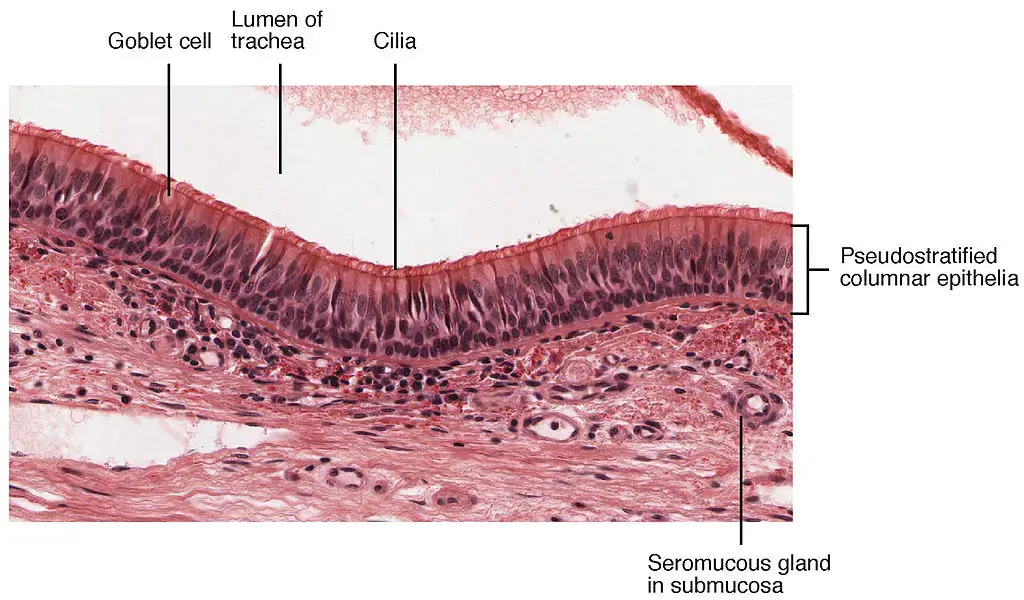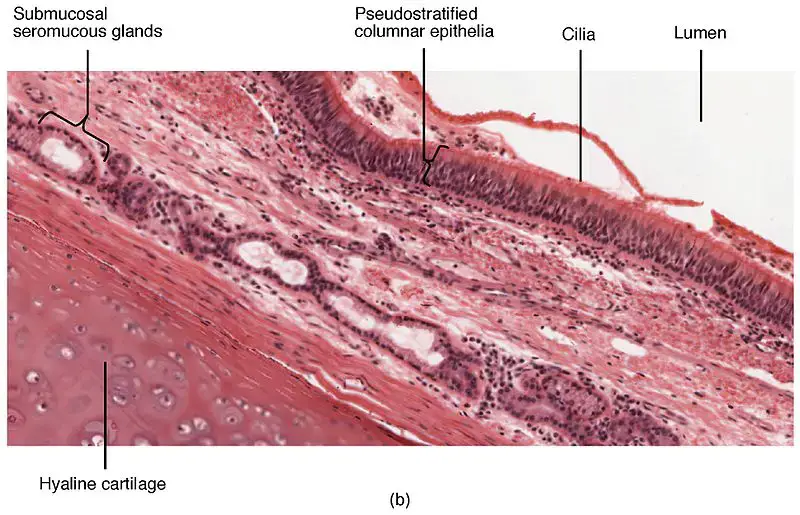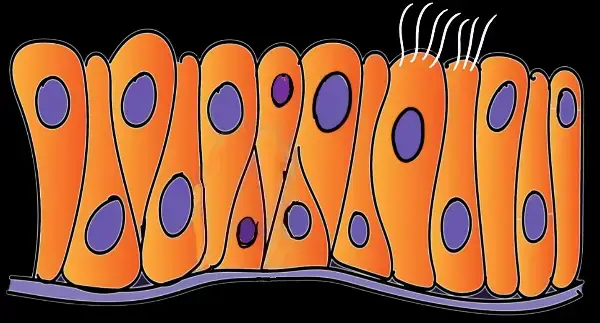Definition of Pseudostratified columnar epithelium
A pseudostratified columnar epithelium an epithelium made up of only one layer of cells which creates the appearance of multiple layers due to the nuclei in the cells are located at various levels. It is histologically an epithelium that is simple, even though when viewed from a cross-section it could appear as an epithelium stratified. The pseudostratified epithelium composed of squamous or cuboidal cells is extremely uncommon, while the columnar epithelium that is pseudostratified occurs across the body.
Pseudostratified columnar epithelium Structure
- A pseudostratified epithelium columnar comprises of cells that resemble columns and have different sizes.
- The cells aren’t of equal height and consequently, not all cells are on the have the same apical area of the tissue.
- This creates the illusion of layers, as the nuclei from these various cells get placed at various layers of tissue.
- Cells, as is the other epithelial tissues are joined through gaps junctions, adhesions or desmosomes. This ensures it is tightly packed without leaks or gaps.
- The cells are closely adjacent to each other and goblet cells are located between cells within the pseudostratified columnar epithelium that is ciliated. The goblet cells producing mucus extend all the way to the apical portion of.
- In the same way, those cells in the epithelium columnar additionally equipped with a huge amount of organelles. They are therefore able to achieve more absorption and production than other cells.
- The complexes created by desmosomes and junctions form on the apical side of certain cells. This gives the appearance of bulging at the apical surfaces.
- In the epithelial tissues the epithelium isn’t equipped with an own supply of blood. The water, nutrients, and exchange of gas happen by diffusion into the vasculated tissues underneath.
- The epithelium is however, innervated and has it’s own source of nerve.
- Certain cells in the columnar epithelium that is pseudostratified contain cilia on the apical surfaces that are involved in the sensory and motility.
Types of Pseudostratified Columnar Epithelia
In a way, based on the existence or absence of cilia pseudostratified columnar epithelium comes in two kinds:
1. Ciliated pseudostratified columnar epithelium
The epithelium is composed of columnar cells that are irregularly sized that contain cilia on their apical surfaces make up the pseudostratified columnar epithelium. The cilia range from 5 to 10 millimeters long and 0.2 millimeters in diameter. Each cilium is surrounded by a central structure that is composed of nine microtubule doublets, which are surrounded with two microtubules in the central.
Cilia show rapid beat patterns that propel a flow of suspended and fluid in a specific direction through the epithelium. They direct the movement of molecules specific directions, which assists in the process of excretion and secretion. Within the reproductive organs of females the cilia aid in the movement of the ovum along the fallopian tube and into the uterus.
Additionally, a few goblets that secrete mucus are located between these cells and extend all the way towards the apical side to let the secretion out. After release, mucus builds up in the upper part in the cell which causes it to expand, making the whole cell look like the shape of a wine glass or goblet.
2. Non-ciliated pseudostratified columnar epithelium
The columnar epithelium, which is non-ciliated, pseudostratified is composed of irregularly-sized columnar cells with no cilia. They lack cilia, however they have stereocilia that tend to be larger and less mobile than microvilli. They also display the ability to branch distally. Stereocilia resemble microvilli by containing the array of microfilaments and actin binding proteins with the same diameter.
Similar to microvilli and stereocilia, stereocilia enhance the cell’s surface which facilitates absorption. They are located on the pseudostratified columnar epithelium that is part of the male reproductive system.
Functions of the pseudostratified columnar epithelium
The main purpose of the columnar epithelium is to secrete and absorption. The columnar epithelium, which is non-ciliated and pseudostratified is involved in the absorption process and secretion. However, the columnar epithelium that is ciliated assists in the movement or transport of cells and molecules from one place to the other and is also a shield against certain diseases.
1. Protection
The epithelium found in various regions throughout the body functions as a barrier that protects the body and shields the involuntary movement of compounds. The complex created by the junctions between the apical and lateral surfaces of the cells serves as a gatekeeper filtering undesirable molecules, and permitting the passage of water and nutrients. In the same way, the mucus released by goblet cells within the ciliated pseudostratified columnar esthylium collects foreign particles and cilia remove mucus and allow it to be eliminated out of the body. The existence of pseudostratified epithelium within the respiratory tract’s upper part shields the tissues beneath from particles of dust, pollutants, pollen and a myriad of pathogens and corrosive substances.
2. Absorption
The stereocilia on the apical surfaces of cells improves the absorptive surface of epithelium within the reproductive organs of males, which lets the sperm be concentrated through the absorption of fluid prior to the ejaculation process. The cells are also supplied with extra membrane-bound proteins which aid in the absorption of these nutrients.
3. Secretion
The goblet cells between columnar cells of the tissue produce mucus which helps to lubricate the linings of the reproductive and respiratory tracts and the majority in the tract for urinary elimination. The mucus that is found in the respiratory tract protects against foreign particles , and also prevents their entry into the nasal passageway to the respiratory tract’s inner lining.
4. Transportation
The columnar epithelium, which is non-ciliated and pseudostratified forms the large excretory ducts of certain glands, which aids in the transport of hormones and enzymes to their sites of action. The same way the cilia that are present in the columnar epithelium that is ciliated in the respiratory tract beat together moving foreign particles and mucus towards the throat, from which is where they are able to be swallowed or expelled. The pseudostratified columnar epithelium that lines the epididymis of male reproductive system contains cilia that help transport immotile sperm that has been ejected from the testes to the epididymis.
Pseudostratified columnar epithelium location and Examples
- Ciliated pseudostratified columnar esthelia is the kind of epithelium that is that is found in the linings the trachea, as well as the upper respiratory tract that allows for the humidification and filtering of the incoming air.
- Non-ciliated pseudostratified columnar epithelia can be located in the prostate as well as the membranous portion of the male vas deferens.
- Pseudostratified columnar epithelia that have stereocilia are found within the epididymis. Stereocilia found in the epididymis is not cilia as their cytoskeleton consists of actin filaments and not microtubules. They’re molecularly and structurally closer to microvilli, but not as much as real cilia.
- Pseudostratified columnar epithelia can be found that form the straight tubular glands that make up the female endometrium. They also appear within the internal portion in the ear.
Images of Pseudostratified columnar epithelium



FAQ
Q1. how would you distinguish pseudostratified columnar epithelium from all other tissues?
- (a) it is composed of a single layer of cells of varying heights; not all cells reach the free surface; and nuclei are at varying heights within cells
- (b) it is technically not a tissue, because it is “pseudostratified”
- (c) it is the only tissue found in both the kidney tubules and in the kidney glomeruli, so if you view a kidney section you can be sure it is pseudostratified columnar epithelium
- (d) it is ciliated and composed of cuboidal cells and columnar cells, with some nucleated and some anucleate cells
Ans: (a) it is composed of a single layer of cells of varying heights; not all cells reach the free surface; and nuclei are at varying heights within cells
Q2. where is pseudostratified columnar epithelium found? Or where is pseudostratified columnar epithelium located?
Ciliated pseudostratified columnar esthelia is the type of epithelium that is located in the linings of the trachea and the respiratory tract’s upper part, that allows for the humidification and filtering of the incoming air.
Q3. what is the function of pseudostratified columnar epithelium?
The role of the pseudostratified columnar epithelium is the absorption and release of mucus. It also protects against foreign particles (dust or pathogens), as well as allergens) and the transportation of substances such as the hormones as well as enzymes.
Q4. which region(s) of the pharynx is lined by pseudostratified ciliated columnar epithelium?
- A Olfactory region of the nasal chamber
- B Trachea
- C Respiratory region of the nasal chamber
- D All the above
Ans: The correct option is D All the above
The nasal cavity is separated into three parts: the respiratory, vestibular and the olfactory. The vestibular zone is lined with skin, sebaceous glands, and hair which block the entrance of dust particles that are large in size. The respiratory tract is lined by a pseudostratified glandular epithelium with columnar ciliated that is able to filter and condition the air. The olfactory region is present next to it which is lined by the olfactory epithelium/Schneiderian membrane which senses the smell. It is lined with an extremely thin layer of pseudo-stratified ciliated epithelium . They are highly vascularized connective tissue.
The trachea is composed of four layers: mucosa, submucosa, musculocartilaginous layer and tunica adventitia which are laid out from the inside to outwards, respectively. In the mucosa, the most inner layer is epithelium, which is a pseudostratified columnar ciliated epithelium . Thus, both the trachea as well as the respiratory region are surrounded by pseudostratified columnar ciliated epithelium.
Q5. why are certain epithelial cells called pseudostratified columnar epithelium?
Epithelial cells that are certain types can be known as pseudostratified columnar epithelium due to the fact that they appear to be layered but they all touch the basement membrane.
- Text Highlighting: Select any text in the post content to highlight it
- Text Annotation: Select text and add comments with annotations
- Comment Management: Edit or delete your own comments
- Highlight Management: Remove your own highlights
How to use: Simply select any text in the post content above, and you'll see annotation options. Login here or create an account to get started.